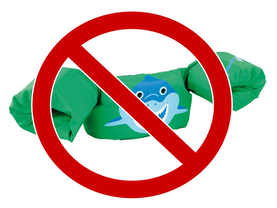Water Safety Tips
Puddle jumpers... just say NO! Really!

Drowning is the leading cause of death for kids under age 5, and the numbers are actually on the rise. I fear that the recent surge in the use of "puddle jumpers" is to blame in many of these cases. These were not popular when my children were young, just 10 years ago.
Flotation devices like puddle jumpers give children a false sense of confidence. While I don't want kids to fear the water, I'd rather they have a healthy respect for it, than a false sense of confidence. Children who wear puddle jumpers learn to LOVE being in the water, despite having NO skills to survive in the water, and that is a dangerous combination. Despite what they may tell you, young children do not have the cognitive development to completely understand that the puddle jumper is what is keeping them afloat, and they do not fully understand what will happen if they jump in without it. There are COUNTLESS stories of young kids getting in the water or falling in without their puddle jumper on (some even figuring out how to take it off on their own), and unfortunately, many of these children do not survive or have lifelong impairments as a result.
Secondly, puddle jumpers teach bad habits that are hard to overcome in lessons. They teach kids to kick in a bicycle motion and create a muscle memory of "swimming" vertically with your head out of water. This posture causes them to tire very quickly and impedes forward movement. These bad habits are very difficult to overcome in a few weeks of lessons. Not only that, but these "bad habits" are what your child will revert to in an emergency, and this posture is known by lifeguards as the "drowning position," as that is what it leads to.
Flotation devices like puddle jumpers give children a false sense of confidence. While I don't want kids to fear the water, I'd rather they have a healthy respect for it, than a false sense of confidence. Children who wear puddle jumpers learn to LOVE being in the water, despite having NO skills to survive in the water, and that is a dangerous combination. Despite what they may tell you, young children do not have the cognitive development to completely understand that the puddle jumper is what is keeping them afloat, and they do not fully understand what will happen if they jump in without it. There are COUNTLESS stories of young kids getting in the water or falling in without their puddle jumper on (some even figuring out how to take it off on their own), and unfortunately, many of these children do not survive or have lifelong impairments as a result.
Secondly, puddle jumpers teach bad habits that are hard to overcome in lessons. They teach kids to kick in a bicycle motion and create a muscle memory of "swimming" vertically with your head out of water. This posture causes them to tire very quickly and impedes forward movement. These bad habits are very difficult to overcome in a few weeks of lessons. Not only that, but these "bad habits" are what your child will revert to in an emergency, and this posture is known by lifeguards as the "drowning position," as that is what it leads to.
But it won't happen to me. I always watch my kids!
Yes, you are a loving, attentive parent. Most parents are, actually. But drowning can happen in as little as 30 seconds, and it is very easy to get distracted or lose track of your child for a brief moment. Maybe you are helping another child, changing a diaper, looking for something in your bag, or reading a quick email. It really does happen that fast, and it is silent. Moreover, nearly 70% of drownings happen when kids were not expected to be near the water at all (i.e. not while everyone is swimming at the pool), and nearly all were last seen less than 5 minutes earlier. If you've ever caught your child in some sort of mischief, like marker or makeup all over their body or your wall, you've lost track of them for long enough for them to drown.
So what SHOULD you do with young kids?

- If you have a pool at home, get a child-proof pool fence. If a fence is not possible, invest in a pool alarm. You can also get a pool alarm that your child wears, which can be helpful if you're at a friend of family member's house. These alarms will go off if they are submerged in water. Keep doors locked at all times. You may need to install a lock that is out of your child’s reach.
- Enroll your child in swim lessons early so they can learn some swim skills that you can practice together.
- Get in the pool with your kids. If they can't swim yet, hold them in the water, let them splash, practice putting their face in, hold onto you or the side of the pool and practice kicking, or jump in to you (let them go under and then pick them up so they learn what happens when they jump in, and they start to get comfortable going under water). Your days of sitting by the pool chatting with friends or reading a book will come when they are older. For now, get in with your kids, and encourage your friends to do the same! This used to be the norm, and I hope it will be again.
- If you can't handle your kids at the pool (maybe you have more than one who are not strong swimmers) or you just don't want to get in, then stick to splash pads and baby pools until they are better swimmers. You'll have plenty of days to spend at the pool when they are older, and it will be more enjoyable and less stressful!
- When in groups, always designate an adult to be the pool watcher. It is easy to get distracted while chatting with other adults.
- Before leaving your child at the house of a friend, babysitter, or relative, find out if they have a pool, and if so, what safety measures they have in place. If there aren't sufficient safety measures in place, don't leave your child there.
- Teach your child what to do if another child falls in. Kids should get help from an adult and NEVER jump in to save another child.
The KEY to drowning prevention is LAYERS of protection. If one layer fails, another one is there to save the day. Layers include close supervision, pool fences, pool alarms, and swim lessons. Swim lessons are the LAST layer of protection. Your child should only have to use them if all of the other layers of protection have failed.
